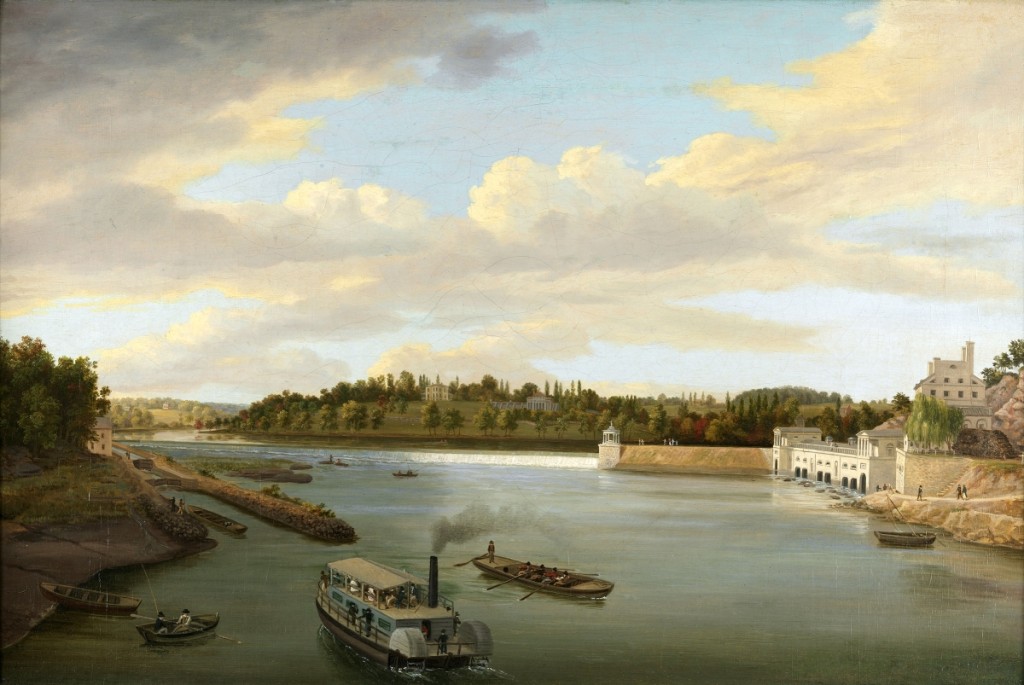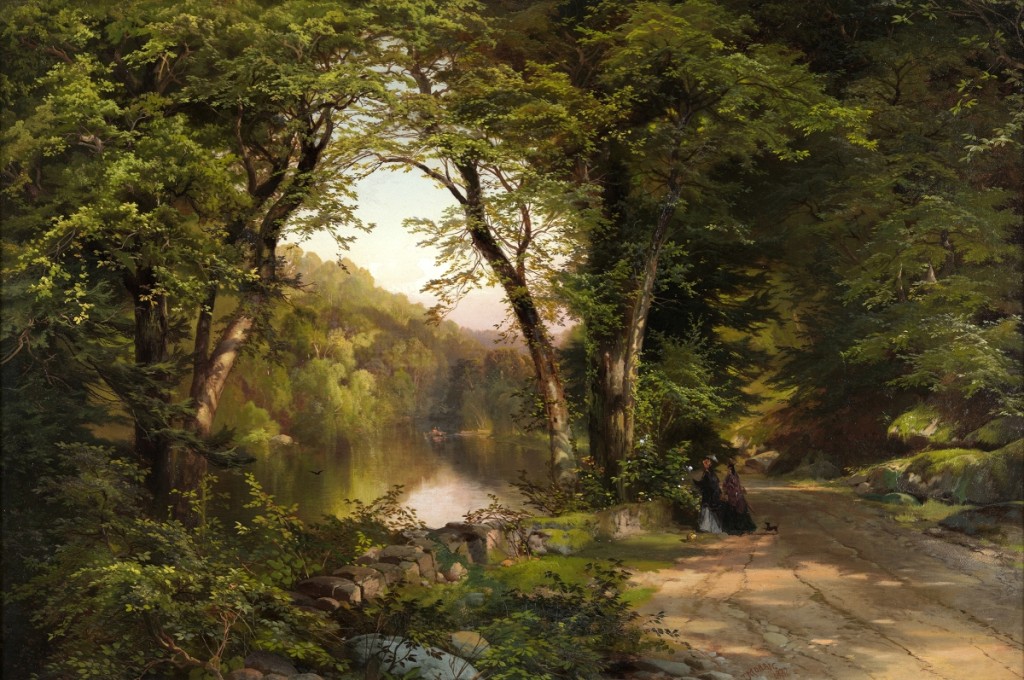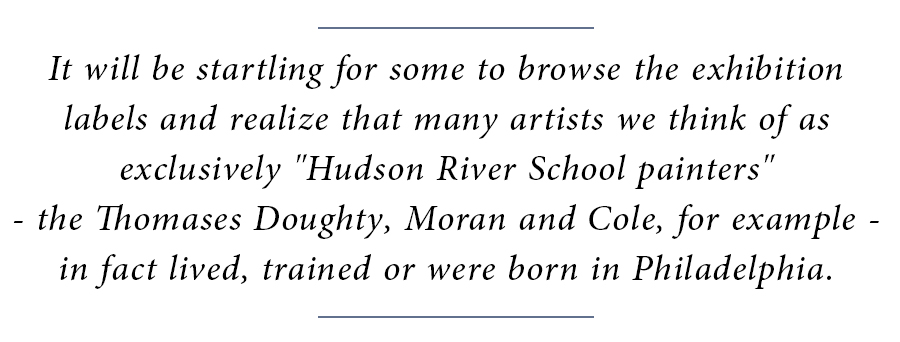
“Fairmount Water Works” by Thomas Birch (1779-1851), 1821. Oil on canvas, 20-1/8 by 30-1/16 inches.
Pennsylvania Academy of the Fine Arts, Philadelphia, bequest of Charles Graff.
By Jessica Skwire Routhier
PHILADELPHIA – America loves its origin stories: the Niña, the Pinta, and the Santa María; Pilgrim Rock; the Boston Tea Party. The history of American art also has its origin stories, and one of them is the tale in which a young British-born painter named Thomas Cole moves from Philadelphia to New York and, for the first time, takes a sketching trip up the Hudson River, thus founding what we now know as the Hudson River School of American landscape painting.
Like other foundational legends, this one is true in its broad outlines, but the way in which it has solidified in the public consciousness has suppressed some finer points. Often forgotten in this narrative is the place Cole was before he was in New York: Philadelphia. “From the Schuylkill to the Hudson: Landscapes of the Early American Republic,” at the Pennsylvania Academy of the Fine Arts (PAFA) through December 29, offers an alternative view of the rise of American landscape painting, one that began a generation before the Hudson River School in the city on the Schuylkill.
“Everybody has always kind of known that,” says PAFA curator Anna O. Marley recently, pointing out that recent Cole exhibitions at the Met and the Thomas Cole National Historic Site have included the Philadelphia chapter of Cole’s life in timelines of his artistic development. But the current show is the first to foreground Philadelphia and offer an alternative view of the genesis of American landscape painting. “I think the myth of the Hudson River School…is so dominant we haven’t really been willing to dislodge [it],” adds Marley, “but Cole and [Hudson River School painter Frederic Edwin] Church came out of a longer tradition…I think that as the field of American art becomes more sophisticated, we have to have more nuanced understandings of the origins of landscape painting traditions in this country.”
To wit: Philadelphia artists like the brothers Robert and Charles Willson Peale were incorporating landscape painting into their work in the 1770s and 1780s – more than 50 years before Thomas Cole’s momentous trip upriver – eventually going on to paint pure landscapes. Also in this earliest era, as Marley writes in her catalog essay, the fine homes and scenic views of Philadelphia provided subject matter for several important suites of engravings, designed by William Russell Birch, Joshua Shaw and others. These print series were distributed internationally, conveying the sophistication of Philadelphia’s – and America’s – art and architecture, along with its natural beauty.
One of the most widely distributed images of Philadelphia was its famed waterworks, universally renowned as a masterpiece of architecture and engineering. Still in place on the banks of the Schuylkill, in the heart of the city, the waterworks were originally constructed in 1815, and were immediately a point of interest. Charles Dickens visited in 1842 and marveled at the beauty and efficiency of the enterprise: “Philadelphia is most bountifully provided with fresh water, which is showered and jerked about, and turned on, and poured off, everywhere. The Water Works, which are on a height near the city, are no less ornamental than useful.”
Multiple prints and other artistic iterations of the waterworks circulated through the Atlantic world and beyond in Dickens’ era, many of them based on an original 1821 painting by Thomas Birch that provides the cover image for the “Schuylkill to the Hudson” exhibition catalog. Birch’s composition also appears in an engraving of 1824 and on a cup and saucer made in China; all three objects are in the present exhibition. “That just encapsulates for me, those three objects, the whole story of the show,” says Marley. “To see this commissioned teacup that was hand painted in porcelain, in China, in the 1820s, that was then made to bring back to the US market – with this scene based on a print based on a painting in Philadelphia – really showed me the global story that these art objects were telling.”
But the story is resolutely local as well as global – a paeon to the City of Brotherly Love and its many natural and manmade wonders: the waterworks, the ferries, the gracious public park that was Laurel Hill Cemetery. In fact, the paradoxical union between nature and industry that found a locus in Philadelphia is a theme throughout the objects selected for the show. The transfer-printed china – much of it borrowed from Winterthur or the Philadelphia Museum of Art to enhance PAFA’s holdings – is an obvious example: resource-heavy art objects produced for mass consumption and shipped around the globe, decorated with specific Philadelphia landscapes that are pleasingly unspoiled. In addition to the export teacup, a Staffordshire pitcher also features the waterworks, as do a series of porcelain pitchers made by the local Tucker manufactory; there is also a Staffordshire dish with a view of a rural ferry across the Schuylkill, based on a William Russell Birch print. In all, human interventions on the landscape are seen in an unequivocally positive light: worthy of commemoration and celebration.
This aspect of the exhibition touches upon a larger conversation within the emerging field of ecocriticism that is currently happening among museums and art historians (see “Nature’s Nation,” October 30, 2018 issue). While Marley hesitates to describe the present show as an ecocritical one, stressing that her approach is more one of traditional material culture studies, she agrees that it is “very much informed by our current discussions about colonialism and empire.” She notes that Frederic Edwin Church painted his monumental “Valley of Santa Ysabel, Granada,” a recent PAFA acquisition and one of the concluding paintings of the installation, in response to the news of an earthquake in this place he had visited years before. “I think he was learning about it in a very sort of elegiac way,” Marley notes. “You can’t not think about the physical environment and how it affected these artists.”
Church’s painting dates to 1875 and is thus at the outer edge of the time period covered by the exhibition, which goes up to the Centennial International Exhibition of 1876, held in Philadelphia. The official World’s Fair of that year, the Centennial Exhibition was designed, in part, to celebrate the 100th birthday of the United States. “I had considered different ending points for the show,” says Marley, but in the end she decided that the 1870s made sense in several different ways. Beyond the satisfying century-wide span between revolution and commemoration, this was also a time when American landscape painting underwent yet another transformative change – a watershed moment, if you will.
“It’s the 1870s when the Hudson River School reaches its apex,” Marley notes, “and then suddenly it starts to become unpopular,” a phenomenon that scholars like Kimberly Orcutt have recently connected to tensions involved in the art display at the Centennial itself. Paintings like Church’s illustrate that apex, while an ancillary display of Philadelphia paintings dating from 1877 to 1946 convey what was to replace it. The Centennial is not just a concluding idea but a material presence in the show, the subject of Edmund Darch Lewis’ large-scale view of a distant Philadelphia, seen over an autumnal Schuylkill, with the dome of the Centennial building punctuating the horizon.

“Two Women in the Woods” by Thomas Moran (1837-1926), 1870. Oil on canvas, 20 by 30 inches. Pennsylvania Academy of the Fine Arts, Philadelphia, Orton P. Jackson Fund in memory of Emily Penrose Jackson.
It was a strategic curatorial choice to bracket the show with Peale and Birch on the one hand, and Lewis on the other, because doing so keeps the focus on Philadelphia’s artists and landmarks. In between, there are digressions: artists like Church, Albert Bierstadt and Asher B. Durand certainly exhibited at PAFA in their lifetimes, as did most other leading artists of the time, but beyond that they have no particular connection to the city, and their paintings in the show are of other places. Cole, too, is represented not by work created in or inspired by Philadelphia, but by views of Niagara Falls and Italy. Such works are offered more as examples of the type of landscape painting that became dominant in Nineteenth Century America and that, as Marley argues, was forged in Philadelphia.
Still, it will be startling for some to browse the exhibition labels and realize that many artists we think of as exclusively “Hudson River School painters” – the Thomases Doughty, Moran and Cole, for example – in fact lived, trained or were born in Philadelphia. “PAFA is founded in 1805,” says Marley, “Twenty years before the National Academy of Design, and 20 years before Thomas Cole takes that fateful trip up the Hudson River.” With the nation’s first art academy and, thanks to the Peale family, its first museum, Philadelphia really was the cultural and artistic epicenter of the new republic, at least initially, a role that has gone underrecognized by generations of scholars eager to canonize the Hudson River.
And so let us not forget the “other” river, the Schuylkill, that appears in so many of the paintings in this exhibition and provides a primary organizing theme. “What might have seemed like a gimmick at first,” says Marley, referring to the kind of face-off between Hudson and Schuylkill that is implied in the show’s title, “is not a gimmick at all… The river is an incredibly powerful theme because it was the economic engine that drove the development of the early republic.” In her words, “rivers create economics, and economics create art, and bodies of water also create empire and empires also craft art.” It’s no accident that the waterworks were built on the river, or the Centennial building, or indeed the city itself. And it’s no accident that paintings, prints and – yes – decorative arts depict ways of getting to, from, in and around the city that all feature the river.
“I think now we see rivers as beautiful, as aesthetic, as calming, as relaxing,” Marley adds. “And they are all those things to us. But I think to many of these artists, they were also hyperaware of the industrial and economic and political importance of these rivers as they were painting them.”
The Pennsylvania Academy of the Fine Arts is at 118-128 North Broad Street. For information, www.pafa.org or 215-972-7600.




















